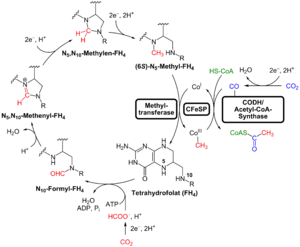Wood–Ljungdahl pathway

The Wood–Ljungdahl pathway is a set of biochemical reactions used by some bacteria and archaea called acetogens. It is also known as the reductive acetyl-coenzyme A (Acetyl-CoA) pathway.[1] This pathway enables these organisms to use hydrogen as an electron donor, and carbon dioxide as an electron acceptor and as a building block for biosynthesis.
In this pathway carbon dioxide is reduced to carbon monoxide and formic acid or directly into a formyl group, the formyl group is reduced to a methyl group and then combined with the carbon monoxide and Coenzyme A to produce acetyl-CoA. Two specific enzymes participate on the carbon monoxide side of the pathway: CO Dehydrogenase and acetyl-CoA synthase. The former catalyzes the reduction of the CO2 and the latter combines the resulting CO with a methyl group to give acetyl-CoA.[1][2]
The pathway occurs in bacteria and archaea, e.g. methanogens[3] and in acetate-producing bacteria such as Clostridium. Unlike the Reverse Krebs cycle and the Calvin cycle, this process is not cyclic. A recent study of the genomes of a set of bacteria and archaea suggests that the last universal common ancestor (LUCA) of all cells was using the Wood–Ljungdahl pathway in a hydrothermal setting.[4] Phylometabolic reconstructions[5] as well as chemical experiments suggest the pathway may have prebiotic origins.[6]
See also
References
- 1 2 Ragsdale Stephen W (2006). "Metals and Their Scaffolds To Promote Difficult Enzymatic Reactions". Chem. Rev. 106 (8): 3317–3337. doi:10.1021/cr0503153. PMID 16895330.
- ↑ Paul A. Lindahl "Nickel-Carbon Bonds in Acetyl-Coenzyme A Synthases/Carbon Monoxide Dehydrogenases" Met. Ions Life Sci. 2009, volume 6, pp. 133–150. doi:10.1039/9781847559159-00133
- ↑ Matschiavelli, N.; Oelgeschlager, E.; Cocchiararo, B.; Finke, J.; Rother, M. (2012). "Function and regulation of isoforms of carbon monoxide dehydrogenase/acetyl-CoA synthase in Methanosarcina acetivorans". Journal of Bacteriology. 194 (19): 5377–87. doi:10.1128/JB.00881-12. PMC 3457241. PMID 22865842.
- ↑ M. C. Weiss; et al. (2016). "The physiology and habitat of the last universal common ancestor". Nature Microbiology. 1 (16116). doi:10.1038/nmicrobiol.2016.116. PMID 27562259.
- ↑ Braakman, Rogier; Smith, Eric (2012-04-19). "The Emergence and Early Evolution of Biological Carbon-Fixation". PLOS Computational Biology. 8 (4): e1002455. doi:10.1371/journal.pcbi.1002455. ISSN 1553-7358.
- ↑ Varma, Sreejith J.; Muchowska, Kamila B.; Chatelain, Paul; Moran, Joseph (2018-04-23). "Native iron reduces CO2 to intermediates and end-products of the acetyl-CoA pathway". Nature Ecology & Evolution. doi:10.1038/s41559-018-0542-2. ISSN 2397-334X.